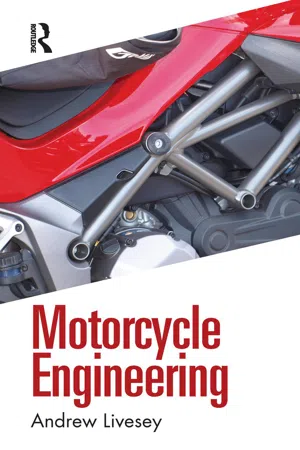
- 362 pages
- English
- ePUB (mobile friendly)
- Available on iOS & Android
Motorcycle Engineering
About this book
Motorcycle Engineering is a primer and technical introduction for anyone interested in motorcycles, motorcycling, and the motorcycle industry. It provides insight into how motorcycles are made and operated.
Motorcycles, mopeds, and scooters are important factors in world transport, and they are playing an increasingly important role in transport policy as we move towards greater environmental awareness. Motorcycles and scooters give freedom of personal transport that enable large commuter distances to be covered quickly and easily. Their small footprint offers easy storage as only minimal space is required. To celebrate the importance of motorcycles on the world stage, a brief history is included with a detailed timeline detailing the development of the motorcycle alongside major world events.
Written in an accessible fashion, no previous knowledge of engineering or technology is required, as all technical terms are readily explained and a glossary and abbreviation list is included. Whether you are an enthusiast, racer, student, or industry professional, you will surely find this an enjoyable read and a handy reference book on your shelf.
Frequently asked questions
- Essential is ideal for learners and professionals who enjoy exploring a wide range of subjects. Access the Essential Library with 800,000+ trusted titles and best-sellers across business, personal growth, and the humanities. Includes unlimited reading time and Standard Read Aloud voice.
- Complete: Perfect for advanced learners and researchers needing full, unrestricted access. Unlock 1.4M+ books across hundreds of subjects, including academic and specialized titles. The Complete Plan also includes advanced features like Premium Read Aloud and Research Assistant.
Please note we cannot support devices running on iOS 13 and Android 7 or earlier. Learn more about using the app.
Information
Chapter 1
Power unit – engine

IDENTIFICATION
ENGINE PERFORMANCE
- Power – this is work done in unit time.
- Torque – turning moment about a point.
- * is multiply and / is divide
Bike/car | Capacity | BHP | Weight (kg) | BHP per ton |
|---|---|---|---|---|
Kawasaki ZX6R | 599 cc | 130 | 185 | 702 |
Harley Davidson | 883 cc | 53 | 263 | 201 |
Triumph Bonneville T120 | 1198 cc | 80 | 224 | 357 |
Suzuki Hayabusa | 1299 cc | 173 | 251 | 689 |
Kawasaki H2 motorcycle | 1000 cc supercharged | 310 | 215 | 1442 |
Typical BTCC car | 2-liter turbo | 350 | 1000 | 350 |
German Touring Motorcycle - DTM | 4-liter supercharged | 500 | 112... |
Table of contents
- Cover
- Half Title
- Title Page
- Copyright Page
- Contents
- Abbreviations and symbols
- General abbreviations
- Preface
- 1 Power unit – engine
- 2 Ignition and fuel
- 3 Lubrication and cooling
- 4 Health, safety, security, and the environment
- 5 Motorcycle types
- 6 Materials for motorcycles
- 7 Frames and fairings
- 8 Electric motorcycles
- 9 Soldering, brazing, and welding
- 10 Running gear and braking
- 11 Motorcycle electrical and electronic systems
- 12 The motorcycle industry
- 13 Reinforced composite materials
- 14 Data
- 15 Science terminology
- 16 Transmission
- 17 Tuning and customizing
- 18 Inspection, test, and rebuild
- 19 Sustainability
- 20 Brief history of motorcycles
- Appendix – Apprenticeship standard for a motorcycle technician
- Glossary
- Index